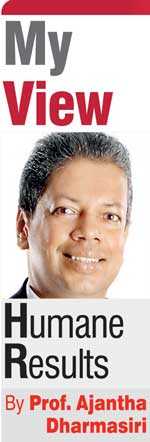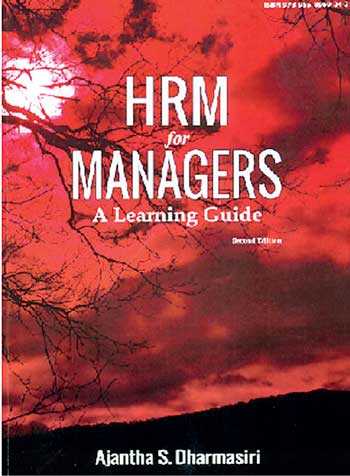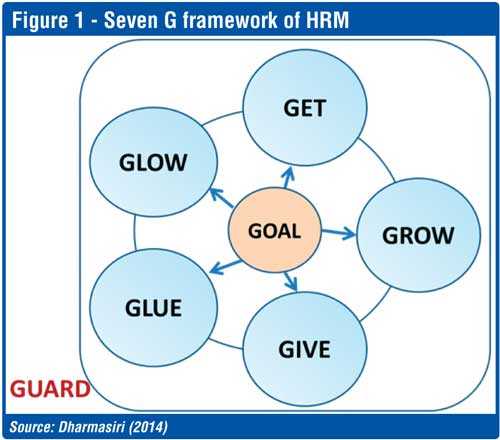Sunday Apr 20, 2025
Sunday Apr 20, 2025
Monday, 28 October 2019 00:03 - - {{hitsCtrl.values.hits}}
We see more of the absence than the presence of proper people management practices in the premier parlours of Sri Lanka. Positions filled based on connections then competencies have resulted in pressing problems than promising prospects.
Politics have encroached professional domains in influencing people hiring and firing, sans developing them. Amidst the fluid political scene of Sri Lanka, I am delighted to share some thoughts about my newly published eighth book, revolving around people management. 
Overview
“People are the critical success factor for strategy implementation,” so said Prof. Linda Graton of London School of Economics. It is not just people but the right people at right positions displaying right performance. The clarity of concepts and concreteness of applications of people management becomes crucial in such a context. For private and public sectors alike, the fundamentals of Human Resource Management are very much applicable and relevant.
I see a Human Resource issue at the macro level baffling the national leaders. How to pick the right person to the right position, especially with regards to the key ones from a national perspective. We have often seen much displeasure expressed by sections of the public through social media about certain appointments.
It is pertinent to mention what advertising tycoon David Oglivy had to say with respect to hiring: “If each of us hires people who are smaller than we are, we shall become a company of dwarfs, but if each of us hires people who are bigger than we are, we will become a company of giants.” In order to hire people with potential, the hiring process has to be professionally designed and executed. This is just one example of the need for proper HRM practices in workplace.
It was Eleanor Roosevelt who said that the future belongs to those who believe in the beauty of their dreams. The second edition of the ‘HRM for Managers: A Learning Guide’ is also such a dream. Having left a multinational career in HRM, over a decade ago, knowledge sharing as a teacher and a trainer has been a pivotal part of my professional life.
Researching, supervising, coaching consulting and leading have been the other vital roles that I needed to play in my multidimensional career. Transitioning from an ‘engineer of electrical’ to an ‘engineer of hearts and minds’ has been a key in influencing my thoughts and tasks.
I propose seven Gs as means of reaping the best from people. They refer to goal, get, give, grow, glue, glow and guard. The book ‘HRM for Managers: A Learning Guide’ revolves around the above seven Gs. Figure 1 contains the details of the Seven G framework.
Seven Gs in a nutshell
Goal occupies the centre stage in setting the direction of the entire organisation. It revolves around the strategic intent, comprising vision, mission or aspiration whatever the terminology may be. Aligning the grooming of people with goals of the organisation should be the right approach. There are numerous occasions where people are unclear about their top goals and priorities.
Strategic Human Resource Management (SHRM) appears prominently in this context. SHRM is an approach that defines how an organisation’s goals will be achieved through people by means of HR strategies and integrated HR policies and practices. It is explicitly linking HRM with strategic management processes of the organisation and to emphasise coordination and congruence among the various human resource management practices. 
Get is all about getting the right people in. The hiring challenge looms large for organisation in diverse environments, mainly owing to a talent gap. “If you give peanuts, you get monkeys,” goes the old saying. What you give to the person who came in by way of reward and recognition is of utmost importance in the context of competition. Your competitor can grab our best talent by “giving” more.
In practical terms, updated job descriptions and job specifications should be available for each position and these should be used in the selection process. Also, selecting the appropriate test in predicting future performance on the specific job is of importance. Managers should be trained on effective hiring, with special emphasis on interviewing skills.
Grow refers to the need to build people. Training and development go hand in hand. The simple difference is that the former is for the present and the latter is for future. In essence, training is to do something. Development is to be someone. Both are intertwined in such a way that training leads to development.
Choices in training and development are captured here. Identification of training and development needs is of utmost importance in this regard. Having clarity on program participants, presenters, designers, coverage, delivery methods and expected behavioural changes are some of the vital components associated.
A growing emphasis on training effectiveness with proper mechanisms to measure is seen in the Sri Lankan private sector. Use of Kirkpatrick model to assess training effectiveness at different levels is one such approach. Return on Training Investment (ROTI) has slowly become a critical factor in the local scenario as well, in justifying the monetary allocation for training and development.
Glue comes next. I would associate the feature ‘binding’ with glue. This refers to the range of choices in retaining talent. Having developed the knowledge and skills of high performers of any organisation, seeing them leaving is the last thing an organisation would like to see.
Meaningful strategies for employee engagement also become relevant in this context. Devising mechanisms to appeal to ‘head’ (stimulating them intellectually) and ‘heart’ (stimulating them emotionally) of employees are the right way forward.
Having an employee suggestion scheme and aptly rewarding the most value-adding suggestion is one such example. Organising a family day where the loved ones of employees proudly associate with the organisation is another example of strengthening the bondage.
Finding out why talented people leave and taking appropriate actions to arrest the outflow should be high in the HR agenda. Offering of a variety of financial and non-financial rewards to stay has also needs to be strengthened.
Encouraging evidence can be found in many leading organisations in Sri Lanka. Yet, the reality remains that, when overseas opportunities are galore with unmatchable financial offers, employees tend to seek better prospects. As I have seen in many organisations, effectively engaging the employees with a clear purpose can be a sure-cure in arresting the rot.
Glow is the subtlest of all. It can appear in several forms. As one such form, choices in promoting the employees can be captured. When a career ladder is available for them to climb, and when the organisation is genuinely providing the support and encouragement, chances of them contributing better in a more committed manner is high. 
Establishing criteria for new jobs, allowing volunteers to take up challenging tasks, evaluating candidates’ potential, supporting of new job holders are some of the key actions in this regard.
Guard is all about the employee protection through a proper policy framework. It may include controls as well as clearance for creative action. A widely shared and wilfully practiced set of corporate values also fall into this perspective. A weak guarding may result in employees having uncertainty and ambiguity with regard to their direction, resulting in lower involvement and contribution.
Seven Gs in action
“If you pick the right people and give them the opportunity to spread their wings, and put compensation as a carrier behind it, you almost don’t have to manage them,” so said one-time most-admired CEO Jack Welch. I see a mixed scene in the Sri Lankan organisations in this respect. Perhaps, an awareness on seven Gs for people management and an adherence to the required priorities could be of help.
In the context of disruption, the term ‘disruptive HRM’ also becomes appropriate. What is disruptive HRM all about? It is essentially challenging the conventional way of doing things. It also involves new initiatives with the use of technology in moving beyond traditional boundaries. ‘On the spot’ feedback, which is real time and online as opposed to annual performance appraisal is one such example.
As I discuss in my book, the term disruption is associated with radical change. Same should apply to disruptive HRM. The definition of HRM coined for Sri Lanka through a series of deliberations at the Chartered Institute of Personnel Management (IPM) can be stated as follows:
A strategic and integrated approach in acquisition, development and engagement of talent, using relevant tools, with proper policies, practices and processes in creating a conducive climate towards achieving organisational excellence and societal well-being (Dharmasiri et al, 2014).
As the above definition revolves around talent, the disruptive HRM should focus on unorthodox ways of ‘winning the war for talent’. Use of social media such as linked-in for hiring talent is one such way. Use of online learning tools as opposed to traditional training is another. Facing triple challenges of being lean, seen and green can be confidently done through disruptive HRM. It poses plenty of challenges for people professionals.
Way forward
‘HRM for Managers: A Learning Guide’ is not meant to be a comprehensive textbook. It is a companion for managers in guiding them to learn HRM in a practical manner. It is intended to assist private sector executives and public sector administrators alike, in inviting them to ‘be brilliant on basics’. The concepts and their usages discussed in the book are relevant to both graduate and postgraduate learners alike.
My invitation is not just to read it, but to recognise the key contents, reflect on the main challenges, relate the basic concepts learnt to the current issues faced by one’s workplace, and reinforce the way how one professionally apply the key lessons, in playing a people manager role in one’s workplace. In essence, knowing should lead to doing and that in turn will deliver results.
May the second edition of ‘HRM for Managers: A Learning Guide’ be a collaboratory companion towards the formation of caring and committed people managers at all levels.
(Prof. Ajantha Dharmasiri can be reached through [email protected], [email protected] or www.ajanthadharmasiri.info.)